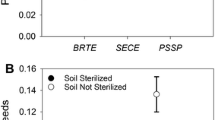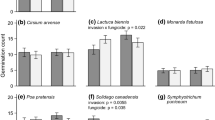Abstract
Soil-borne seed pathogens may play an important role in either hindering or facilitating the spread of invasive exotic plants. We examined whether the invasive shrub Lonicera maackii (Caprifoliaceae) affected fungi-mediated mortality of conspecific and native shrub seeds in a deciduous forest in eastern Missouri. Using a combination of L. maackii removal and fungicide treatments, we found no effect of L. maackii invasion on seed viability of the native Symphoricarpos orbiculatus (Caprifoliaceae) or Cornus drummondii (Cornaceae). In contrast, fungi were significant agents of L. maackii seed mortality in invaded habitats. Losses of L. maackii to soil fungi were also significant in invaded habitats where L. maackii had been removed, although the magnitude of the effect of fungi was lower, suggesting that changes in soil chemistry or microhabitat caused by L. maackii were responsible for affecting fungal seed pathogens. Our work suggests that apparent competition via soil pathogens is not an important factor contributing to impacts of L. maackii on native shrubs. Rather, we found that fungal seed pathogens have density-dependent effects on L. maackii seed survival. Therefore, while fungal pathogens may provide little biotic resistance to early invasion by L. maackii, our study illustrates that more work is needed to understand how changes in fungal pathogens during the course of an invasion contribute to the potential for restoration of invaded systems. More generally, our study suggests that increased rates of fungal pathogen attack may be realized by invasive plants, such as L. maackii, that change the chemical or physical environment of the habitats they invade.

Similar content being viewed by others
References
Allan BF et al (2010) Invasive honeysuckle eradication reduces tick-borne disease risk by altering host dynamics. Proc Natl Acad Sci USA 107:18523–18527
Augspurger CK, Kelly CK (1984) Pathogen mortality of tropical tree seedlings: experimental studies of the effects of dispersal distance, seedling density, and light conditions. Oecologia 61:211–217
Bartuszevige AM, Gorchov DL (2005) Avian seed dispersal of an invasive shrub. Biol Invasions 8:1013–1022
Blaney CS, Kotanen PM (2001) Effects of fungal pathogens on seeds of native and exotic plants: a test using congeneric pairs. J Appl Ecol 38:1104–1113
Blaney CS, Kotanen PM (2002) Persistence in the seed bank: the effects of fungi and invertebrates on seeds of native and exotic plants. Ecoscience 9:509–517
Borer ET, Hosseini PR, Seabloom EW, Dobson AP (2007) Pathogen-induced reversal of native dominance in a grassland community. Proc Natl Acad Sci USA 104:5473–5478
Chambers JC, MacMahon JA (1994) A day in the life of a seed: movements and fates of seeds and their implications for natural and managed systems. Annu Rev Ecol Syst 25:263–292
Cipollini D, Stevenson R, Cipollini K (2008) Contrasting effects of allelochemicals from two invasive plants on the performance of a nonmycorrhizal plant. Int J Plant Sci 169:371–375
Clark CJ, Poulsen JR, Levey DJ, Osenberg CW (2007) Are plant populations seed limited? A critique and meta-analysis of seed addition experiments. Am Nat 170:128–142
Collier MH, Vankat JL, Hughes MR (2002) Diminished plant richness and abundance below Lonicera maackii, an invasive shrub. Am Midl Nat 147:60–71
Conley AK, Watling JI, Orrock JL (2011) Invasive plant alters ability to predict disease vector distribution. Ecol Appl 21:329–334
Connell JH (1971) On the role of natural enemies in preventing competitive exclusion in some marine animals and in rain forest trees. In: den Boer PJ, Gradwell GR (eds) Dynamics of populations. Center for Agricultural Publishing and Documentation, Wageningen, pp 298–312
Dorning M, Cipollini D (2006) Leaf and root extracts of the invasive shrub, Lonicera maackii, inhibit seed germination of three herbs with no autotoxic effects. Plant Ecol 184:287–296
Dostál P (2010) Post-dispersal seed mortality of exotic and native species: effects of fungal pathogens and seed predators. Basic Appl Ecol 11:676–684
Dutra HP, Barnett K, Reinhardt JR, Marquis RJ, Orrock JL (2011) Invasive plant species alters consumer behavior by providing refuge from predation. Oecologia 166:649–657
Gorchov DL, Trisel DE (2003) Competitive effects of the invasive shrub, Lonicera maackii (Rupr.) Herder (Caprifoliaceae) on the growth and survival of native tree seedlings. Plant Ecol 166:13–24
Hidayati SN, Baskin JM, Baskin CC (2000) Dormancy-breaking and germination requirements of seeds of four Lonicera species (Caprifoliaceae) with underdeveloped spatulate embryos. Seed Sci Res 10:459–469
Hidayati SN, Baskin JM, Baskin CC (2001) Dormancy-breaking and germination requirements for seeds of Symphoricarpos orbiculatus (Caprifoliaceae). Am J Bot 88:1444–1451
Holt RD (1977) Predation, apparent competition, and structure of prey communities. Theor Popul Biol 12:197–229
Hutchinson TF, Vankat JL (1997) Invasibility and effects of Amur Honeysuckle in southwestern Ohio forests. Conserv Biol 11:1117–1124
Janzen DH (1970) Herbivores and the number of tree species in tropical forests. Am Nat 104:501–528
Kirkpatrick BL, Bazzaz FA (1979) Influence of certain fungi on seed germination and seedling survival of four colonizing annuals. J Appl Ecol 16:515–527
Kotanen PM (2007) Effects of fungal seed pathogens under conspecific and heterospecific trees in a temperate forest. Can J Bot 85:918–925
Kourtev PS, Ehrenfeld JG, Häggblom M (2003) Experimental analysis of the effect of exotic and native plant species on the structure and function of soil microbial communities. Soil Biol Biochem 35:895–905
Lankau RA (2007) Specialist and generalist herbivores exert opposing selection on a chemical defense. New Phytol 175:176–194
Lankau RA (2011) Intraspecific variation in allelochemistry determines an invasive speces’ impact on soil microbial communities. Oecologia 165:453–463
Levine JM, Vila M, D’Antonio CM, Dukes JS, Grigulis K, Lavorel S (2003) Mechanisms underlying the impacts of exotic plant invasions. Proc R Soc Lond B 270:775–781
Littell RC, Milliken GA, Stroup WW, Wolfinger RD, Schabenberger O (2006) SAS for Mixed Models. SAS Institute, Cary
Luken JO, Goessling N (1995) Seedling distribution and potential persistence of the exotic shrub Lonicera maackii in fragmented forests. Am Midl Nat 133:124–130
Luken JO, Thieret JW (1996) Amur honeysuckle, its fall from grace. Bioscience 46:18–24
Mack RN, Simberloff D, Lonsdale WM, Evans H, Clout M, Bazzaz FA (2000) Biotic invasions: causes, epidemiology, global consequences, and control. Ecol Appl 10:689–710
Madritch MD, Lindroth RL (2009) Removal of invasive shrubs reduces exotic earthworm populations. Biol Invasions 11:663–671
Mangan SA et al (2010) Negative plant-soil feedback predicts tree-species relative abundance in a tropical forest. Nature 466:752–755
Mangla S, Inderjit, Callaway RM (2008) Exotic invasive plant accumulates native soil pathogens which inhibit native plants. J Ecol 96:58–67
Mattos KJ, Orrock JL (2010) Behavioral consequences of plant invasion: an invasive plant alters rodent antipredator behavior. Behav Ecol 21:556–561
McEwan RW, Arthur-Paratley LG, Rieske LK, Arthur MA (2010) A multi-assay comparison of seed germination inhibition by Lonicera maackii and co-occurring native shrubs. Flora 205:475–483
McKinney ML (2004) Measuring floristic homogenization by non-native plants in North America. Glob Ecol Biogeogr 13:47–53
McKinney AM, Goodell K (2010) Shading by invasive shrub reduces seed production and pollinator services in a native herb. Biol Invasions 12:2751–2763
Meiners SJ (2007) Apparent competition: an impact of exotic shrub invasion on tree regeneration. Biol Invasions 9:849–855
Mitschunas N, Filser J, Wagner M (2009) On the use of fungicides in ecological seed burial studies. Seed Sci Res 19:51–60
Noonburg EG, Byers JE (2005) More harm than good: when invader vulnerability to predators enhances impact on native species. Ecology 86:2555–2560
O’Hanlon-Manners DL, Kotanen PM (2006) Losses of seeds of temperate trees to soil fungi: effects of habitat and host ecology. Plant Ecol 187:49–58
Orrock JL, Damschen EI (2005) Fungi-mediated mortality of seeds of two old-field plant species. J Torrey Bot Soc 132:613–617
Orrock JL, Hoisington-López JL (2009) Mortality of exotic and native seeds in invaded and uninvaded habitats. Acta Oecol 35:758–762
Orrock JL, Witter MS (2010) Multiple drivers of apparent competition reduce re-establishment of a native plant species in invaded habitat. Oikos 119:101–108
Orrock JL, Witter MS, Reichman OJ (2008) Apparent competition with an exotic plant reduces native plant establishment. Ecology 89:1168–1174
Orrock JL, Holt RD, Baskett ML (2010) Refuge-mediated apparent competition in plant-consumer interactions. Ecol Lett 13:11–20
Packer A, Clay K (2000) Soil pathogens and spatial patterns of seedling mortality in a temperate tree. Nature 404:278–281
Peters J (ed) (2000) Tetrazolium testing handbook. Contribution no. 29 to the handbook on seed testing. Association of Official Seed Analysts, Lincoln, NE
Ruan Y, Kotraiah V, Stranley DC (1995) Flavonoids stimulate spore germination in Fusarium solani pathogenic on legumes in a manner sensitive to inhibitors of cAMP-dependent protein kinase. Mol Plant Microbe Interact 8:929–938
Schafer M, Kotanen PM (2003) The influence of soil moisture on losses of buried seeds to fungi. Acta Oecol 24:255–263
Seabloom EW, Borer ET, Jolles A, Mitchell CE (2009) Direct and indirect effects of viral pathogens and the environment on invasive grass fecundity in Pacific Coast grasslands. J Ecol 97:1264–1273
Turnbull LA, Crawley MJ, Rees M (2000) Are plant populations seed-limited? A review of seed sowing experiments. Oikos 88:225–238
Vila M et al (2011) Ecological impacts of invasive alien plants: a meta-analysis of their effects on species, communities, and ecosystems. Ecol Lett 14:702–708
Vogelsang KM, Bever JD (2009) Mycorrhizal densities decline in association with nonnative plants and contribute to plant invasion. Ecology 90:399–407
Wagner M, Mitschunas N (2008) Fungal effects on seed bank persistence and potential applications in weed control: a review. Basic Appl Ecol 9:191–203
Watling JI, Orrock JL (2010) Measuring edge contrast using biotic criteria helps define edge effects on the density of an invasive plant. Landsc Ecol 25:69–78
Watling JI, Hickman CR, Lee E, Wang K, Orrock JL (2011a) Extracts of the invasive shrub Lonicera maackii increase mortality and alter behavior of amphibian larvae. Oecologia 165:153–159
Watling JI, Hickman CR, Orrock JL (2011b) Invasive shrub alters native forest amphibian communities. Biological Conservation 144:2597–2601
White EM, Wilson JC, Clarke AR (2006) Biotic indirect effects: a neglected concept in invasion biology. Divers Distrib 12:443–455
Wilcove DS, Rothstein D, Dubow J, Phillips A, Losos E (1998) Quantifying threats to imperiled species in the United States. Bioscience 48:607–615
Acknowledgments
We thank J. Vogel for supporting our ecological research at the Busch Wildlife Conservation Area. We thank M. Craig, E. Damschen, C. Hickman, J. Hoisington-Lopez, and K. Wang for their laboratory and field assistance. We would also like to thank C. Collins, B. Mattingly, and J. Watling for helpful reviews of this manuscript. Portions of this work were funded by a dissertation improvement grant to H.P.D. (NSF 0710341) and grants from the Webster Groves Nature Study Society and the Whitney R. Harris World Ecology Center to H.P.D. These experiments comply with the current laws of the country where the research was conducted.
Author information
Authors and Affiliations
Corresponding author
Additional information
Communicated by Catherine Gehring.
Rights and permissions
About this article
Cite this article
Orrock, J.L., Christopher, C.C. & Dutra, H.P. Seed bank survival of an invasive species, but not of two native species, declines with invasion. Oecologia 168, 1103–1110 (2012). https://doi.org/10.1007/s00442-011-2159-x
Received:
Accepted:
Published:
Issue Date:
DOI: https://doi.org/10.1007/s00442-011-2159-x




